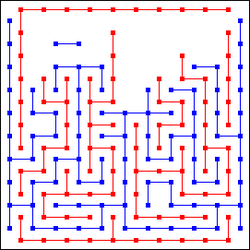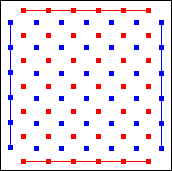Bridg-It
Bridg-It, also known as Gale, is a connection game, similar to Hex. It was invented by the mathematician David Gale, and was described, under the name "Gale", in Martin Gardner's October 1958 column in Scientific American. A version was later marketed by Hasbro under the name "Bridg-It".
Rules
The game is played on a square board. One player (Blue) tries to connect the West and East side, the other tries to connect the North and South side of the board. In each turn, a player draws either a horizontal or a vertical line. Red's lines don't end at the same coordinates as Blue's lines, rather their center points are the same. Lines must not cross each other, which means that every center point can only be occupied by one of the players.
Observations
The game cannot end in a draw.
The game of Bridg-It is equivalent to a special case of Hex where some of the cells are already filled in at the start of the game. For example, 6x6 Brid-it, shown on the right, is equivalent to the following Hex position:
However, since this position never arises during a normal game of Hex, the usual elements of Hex strategy (such as templates, ladder escapes, etc.) do not necessarily apply to Bridg-It.
The first player has a theoretical winning strategy in Bridg-It, for the same reason as in Hex.
Bridg-It is a special case of the Shannon (edge) switching game, for which an optimal move can be found in polynomial time using matroid theory. In other words, the game is solved.
Commercial version
A commercial version of Bridg-It was marketed by Hassenfeld Brothers (Hasbro) in 1960. This version came with a 5x5 grid and 20 bridges for each player. The rules suggested that when a player runs out of bridges, they continue playing by picking up an already placed bridge and moving it elsewhere. This is not quite the same as the original game, where players have an unlimited number of bridges and they are never moved.
Playing online
- A Java implementation of Bridg-It by Roland Illig, using the name "Connecto": http://roland-illig.de/lang.java.connecto.html

